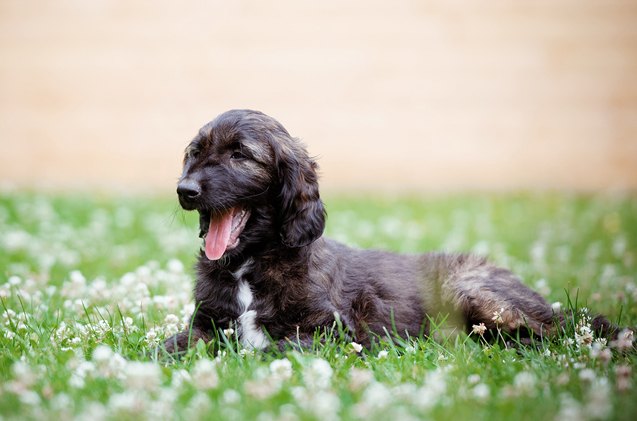Afador


About Afador
A blend of noble Afghan Hound and gentle Labrador Retriever, the handsome Afador is a perfect pet for families with older children and those with previous experience as dog owners. In spite of his retriever lineage, this medium sized pooch has a spirited personality and can be a handful for a novice pet parent who may not be experienced at training a younger dog. His protective nature, wariness of strangers and resounding bark make him perfect for those who want an energetic family pet that brings watchdog benefits.
In spite of his retriever lineage, the Afador has a spirited personality
Afadors are relatively rare, originating in Alaska and bringing together one of the oldest dog breeds in history – the Afghan hound from Afghanistan – and the Labrador retriever from Canada. These days, Afador breeders are focused on stabilizing the breed from an appearance, intelligence and personality standpoint and tend to add more traits from the Labrador side of the family, to make him a better house dog.
Because of the mix of Afghan hound and Labrador retriever, the Afador is considered a hybrid or designer dog and is therefore restricted from joining the elite American Kennel Club roster of purebreds. That said, his parents are members in good standing; the Afghan joined the AKC’s “hound” group back in 1926 and is described as independent, sweet and silly. The Labrador retriever dates back to 1917, when he joined AKC’s “sporting” group and is currently touted as friendly, active and outgoing.
The Afador is an active dog that will require a healthy diet of high-quality kibble and as a “medium” sized breed he will need to be fed between 1.5 to 2.5 cups daily. It’s always wise to do some research into the right mix of vitamins and minerals for your dog and because Afghan’s can suffer from bloat you will need to do your homework or consult your vet. Studies show that frequent small meals coupled with a food that does not have fat or oil (vegetable or animal) listed in the first four ingredients does seem to decrease the risk of gastro-intestinal issues as the fats slow stomach-emptying times compared to high-protein or high-carbohydrate diets.
The Afador is considered a hybrid or designer dog and is therefore restricted from joining
The willful Afador can be a handful to train so best to start early with a particular focus on socialization to lessen his wariness of strangers. The breed is typically independent however is highly intelligent and when training is properly administered, he is known to listen to commands with few repetitions needed. For owners not seasoned at training a head-strong pooch, a professional dog trainer would be a good investment.
The Afador is considered a medium sized breed and when fully grown, he will weight 60-75 pounds.
Described as affectionate, independent, intelligent and loyal, the Afador is a greatly family pet who loves to play outdoors, but adapts well when spending time indoors. He loves kids but his high spirited nature means he does best with older kids who won’t get knocked about if he decides to jump up. He’s an alert and watchful dog who enjoys a good bark and to alert his human pack when strangers arrive. Because he comes from a hounding and sporting background, Afadors are known for their work in search and rescue, tracking, sledding, hunting, police work, narcotics detection, retrieving, herding and agility.
Afadors are relatively healthy dogs but because they are such a rare breed there is little history of specific ailments. As a result, it’s always important that when considering a hybrid dog, potential owners look to the dog’s lineage for clues to potential illnesses. Labrador Retrievers can suffer from hip and elbow dysplasia whereas Afghans can experience “bloat”, a digestive disorder of the stomach as well as acute sensitivity to any type of drug – a concern that is typical of sighthounds
The Afador has a life expectancy of 10 to 12 years. Their lifespan is somewhat shorter than average for breeds.
This active boy is going to need daily exercise to burn off some of his energy. Because he loves to run and play, an off-leash park and tennis ball should be considered part of his regular routine and should augment daily, lengthy walks that include a strong leash or harness. An ideal home environment would include a fully fenced backyard where he can run and stretch his legs to let off steam and because the Afghan side of this breed is known to be a good jumper, consider a minimum six foot high fence.
The Afador loves kids but his high spirited nature means he does best with older kids
While his hybrid-breed status means the Afador is not recognized by the American Kennel Club, he is a member of the Designer Breed Registry (DBR) and the Dog Registry of America, Inc. (DRA)
The Afador’s coat will typically take on the longer, finer characteristic of the Afghan hound along with the breed’s classic longer ears. To keep his long, smooth coat looking sleek and healthy, regular grooming and baths will be required. Brushing his coat at least twice weekly will help avoid matting, tangles and dirt from accumulating and weekly ear-cleaning will prevent the build-up of wax and debris that can result in infection for floppy eared pooches.
Afador pups are deemed highly intelligent from the go-get and early socialization training is encouraged. As a young pup his fuzzy appearance will require minimal grooming but as he grows (typically by nine months of age), his coat will take on the classic Afghan length and texture and will require regular maintenance.
Photo credit: Bitzu Bitzu/Flickr; otsphoto/Bigstock

Sharing space with three seriously judgy Schnoodles and a feline who prefers to be left alone. #LivingMyBestLife
More by Mary Simpson

























